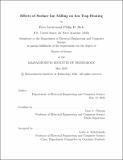Effects of Surface Ion Milling on Ion Trap Heating
Author(s)
Rich, Philip H.
DownloadThesis PDF (7.459Mb)
Advisor
Chuang, Isaac L.
Terms of use
Metadata
Show full item recordAbstract
Ions trapped above a surface electrode chip are a viable candidate for a scalable qubit architecture. The internal electronic state of the ions serve as qubits, while the shared motional modes of ions in a lattice serve as a quantum bus by which information can be shared. Gate operations are performed by applying lasers to drive transitions between internal states in individual qubits and motional states in qubit chains. The coherence time of the coupled motional states is limited by an ion’s heating rate from one motional state to the next. An ion’s motional heating rate is proportional to the electric field noise experienced by the ion at the trap frequency. Measurements of ion heating rates are orders of magnitude larger than those predicted by theoretical models, and temperature dependence of the field noise is an underexplored domain because few systems can vary surface chip temperature across a wide range of temperatures. By exposing a surface electrode trap chip to a beam of trapped ions, surface contaminants on the chip surface can be removed, potentially changing the temperature dependence of the electric field noise experienced by the ion.
This thesis presents the first measurements of the temperature dependence of the heating rate of a single ion trapped above an aluminum trap chip before and after milling, as well as above a platinum chip after milling. We measure heating rates at different trap chip temperatures ranging from 8.5-295 K using sideband ratio spectroscopy of the axial motional state of a trapped strontium-88 ion trapped 50 micrometers above the chip surface at an axial frequency of 1.3MHz. The temperature dependence of the heating rate of an ion above an aluminum chip is shown to not change after ion milling, in sharp contrast with prior results with trap chip surfaces made of other materials. Before and after ion milling, the heating rate follows an activated power law dependence. The unchanged heating rate after ion milling is potentially attributable to the rapid formation of surface oxide layers in aluminum. For heating rates of ions trapped above a platinum chip, the heating rate is consistently measured to be an order of magnitude higher than comparable measurements in aluminum, gold and niobium chips. The reason for these elevated heating rates is unknown at this time, but potentially attributable to fabrication issues.
Date issued
2022-05Department
Massachusetts Institute of Technology. Department of Electrical Engineering and Computer SciencePublisher
Massachusetts Institute of Technology